The Flow of an Electric Current
Transformation of energy at two ends...
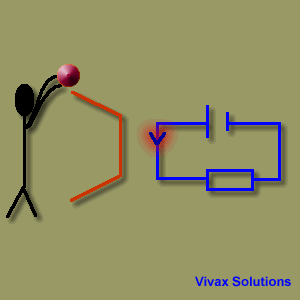
In an electric circuit, there is always a source of energy and a load. The former generates energy and the latter uses it up.
The source can be a cell, battery, dynamo or even a solar panel. The load can be a resistor, a bulb, a fan or heater. We know while the energy transformations take place at the source and the load,
an electric current flows through the circuit from a point of higher potential to that of lower potential.
In the above animation, the rolling balls mimic the electric current by going down from a point of high potential energy to a point of low potential energy. In the same way, the current,
goes from positive terminal - at a higher potential - to the negative - at a lower potential. When the balls reach the feet of the man, however, they have to go from a point of lower potential energy to that of higher potential energy. This is not possible without the
intervention of the man. Therefore, he bends down and picks them up to keep them moving by turning his chemical energy into potential energy.
When charges that carry the electric current reach the negative terminal of the cell,
they face the same challenge. So, the chemical energy in the battery turns into electrical energy to provide the charges with energy to overcome the hurdle. That's why man gets tired and the battery runs down after some time, as their respective energies have turned into different forms.
Electro Motive Force - EMF
The amount of chemical energy that turned into electrical energy in order to move +1 C along a circuit is called Electro Motive Force of the cell.
Units: Volts
Power of a Device
The energy used up by a device in a unit time is called its power.
Units:
P = E/t = J/t = Watts
If the voltage is V and the charge goes through it is Q in time t,
E = QV
So, P = QV/t = ItV/t = VI
P = VI
P = Watts; V = Volts; I = A
The power of a device must be given along with the voltage at which it is valid.
60 W, 240 V means, a power of 60 W is produced at 240 V.
E.g.1
The ratings of a bulb is 60W, 240V. Find its resistance.
P = VI
60 = 240I
I = 1/4 A
V = IR
240 = (1/4)R
R = 960 Ω.
E.g.2
The ratings of an iron is 1200 W, 240 V. Find the current and the energy used up in an hour.
P = VI
1200 = 240I
I = 5 A.
E = Pt
E = 1200 X 3600
E = 4.3 2 x106 J.
E.g.3
The ratings of a bulb is 60 W, 240 V. Due to a power outage, the voltage drops down to 200V. Find the new power of the bulb. What would you notice in the bulb?
P = VI
60 = 240I
I = 1/4 A
V = IR
240 = (1/4)R
R = 960 Ω
When working under new voltage
V = IR
200 = I x 960
I = 5/24 A
P = VI
P = 200 X 5/24
P = 41.7 W
The bulb would get dimmer.
Evidence for the existence of internal resistance of a cell
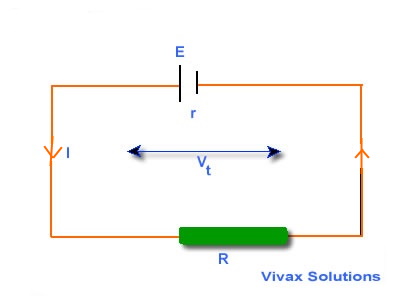
Suppose a charge Q travels along the circuit in time t. The EMF of the cell, the external resistance and the current are E, R and I respectively.
Energy produced by the cell = QE
Energy used up by the external resistor = QVt
In practice, it has been noted QVt < QE
Therefore, we have to account for the loss of energy, other than which occurred at the external resistor. It is certainly caused by the
resistance present in the cell. It is called internal resistance(r).
So the new energy equation becomes,
QE = QVinternal + QVexternal
Since Q = It and V=IR => ItE = Irt + IRt
E = Ir + IR
E = I(r + R)
IR = E - Ir
This is the potential difference across the external resistor (load). Since a voltmeter connected across a cell shows this up, instead of the EMF, it is known as the
Terminal Potential Difference - Vt.
So, Vt = E - Ir
In an open circuit, I = 0. Therefore,
Vt = E.
E.g.
The EMF of a cell is 12V and its internal resistance is 2 Ω. Find the current and the terminal potential difference across the cell, if it is connected to 4Ω external resistor.
E = I(R+r)
12 = I(4 + 2)
I = 2 A
Vt = E - Ir
Vt = 12 - 2x2 = 8
Vt = 8 V.
Connection of Cells
Cells can be connected in series or in parallel or a combination of both.
Connection in Series
The cells are connected in such a way that the current through each one is the same.
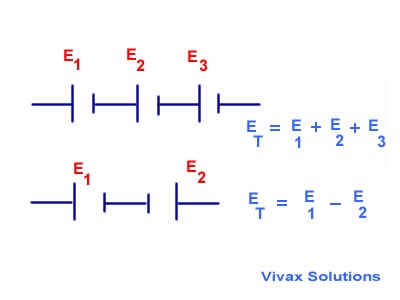
Connection in Parallel
The cells of EMF are connected in such a way that an equal current passes through each one.
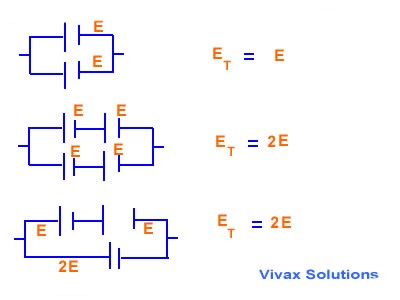
Connection of Resistors
Resistors in Series
If resistors are connected in such a way that the current through each one of them is the same, they are said to be in series.
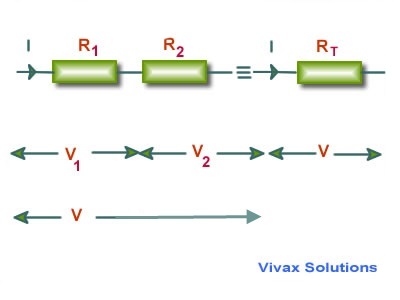
The single resistor that could substitute the combination, must produce a voltage V, when the current through it is I.
For the individual resistors, V = V1 + V2
V = IR1 + IR2
V = I(R1 + R2)
For the equivalent resistor - the substitute,
V = IRT
IRT = I(R1 + R2)
RT = (R1 + R2)
Resistors in Parallel
If resistors are connected in such a way that the voltage across them is the same, they are said to be in parallel.
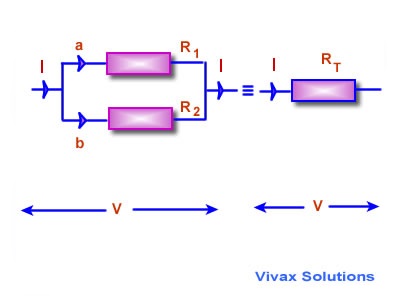
The single resistor that could substitute the combination, must produce a voltage V, when the current through it is I.
For the individual resistors, I = a + b
I = V/R1 + V/R2
V = V(1/R1 + 1/R2)
For the equivalent resistor - the substitute,
I = V/RT
V/RT = V/(1/R1 + 1/R2)
1/RT = 1/R1 + 1/R2
E.g.1
Find the total resistance of the following circuit.
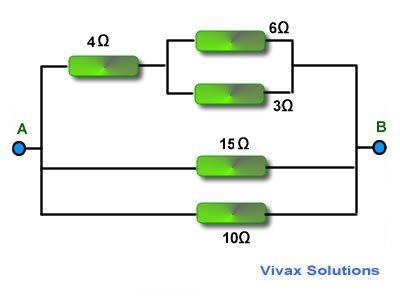
Total resistance across xy:
1/RT = (1/ 6) + (1/3)
1/RT = (1 + 2)/6 = 2/6 = 1/2
RT = 2 Ω
Total resistance of the branch = 2 + 4 = 6 Ω
Total resistance of the three branches which are now in parallel
1/RT = (1/ 6) + (1/15) + (1/10)
1/RT = (5 + 2 + 3)/30 = 10/30 = 1/3
RT = 3 Ω
E.g.2
When two resistors are connected in series, the total resistance is 25 Ω. If they are connected in parallel, the total resistance is 6 Ω. Find the resistance of each.
When they are in series,
RT = x + y = 25 Ω
When they are in parallel,
1/RT = (1/ x) + (1/y)
1/RT = (x + y)/xy = 1/6
6(x + y) = xy
6 X 25 = xy => xy = 150 => x = 150/x
So, 150/x + x = 25
x2 + 150 = 25x
x2 - 25x + 150 = 0
(x - 15)(x - 10) = 0
x = 15 or x = 10
The resistance of each resistor is 15 Ω or 10 Ω
E.g.3
Find the total resistance of the following circuit and the current.
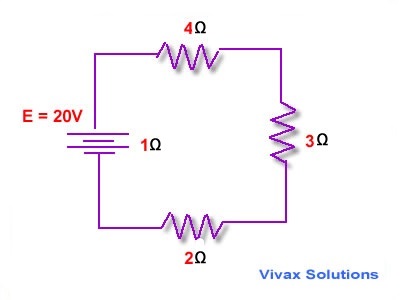
Since all the resistors are in series, total resistance is as follows:
RT = 1 + 2 + 3 + 4 = 10 Ω
Total Current = 20/10 = 2 A
This current flows through each resistor, as they are in series.
E.g.4
Find the total resistance of the following circuit and the currents through each branch.
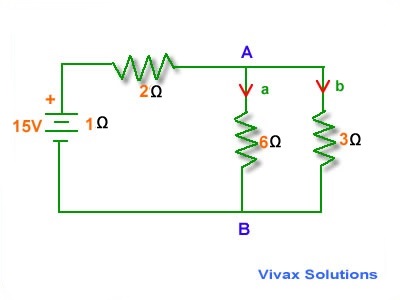
Total resistance across AB:
1/RT = (1/ 6) + (1/3)
1/RT = (1 + 2)/6 = 2/6 = 1/2
RT = 2 Ω
Total resistance of the circuit = 2 + 2 + 1 = 5 Ω
Total Current = 15/5 = 3 A
This current splits up at A, in inverse proportion to the resistance of each branch - the greater the resistance, the smaller the current that goes through it.
Since the two resistances are in parallel,
6a = 3b
b = 2a
a + b = 3
3a = 3 => a=1A ; b = 2 A.
Other resistors get a current of 3 A.
Advanced Questions on resistors in circuits
Find the total resistance of the following circuits:
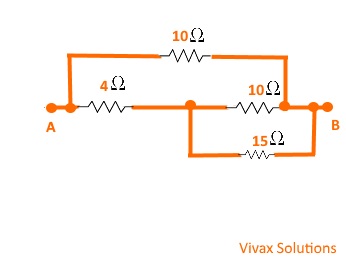
Ans:5 Ω
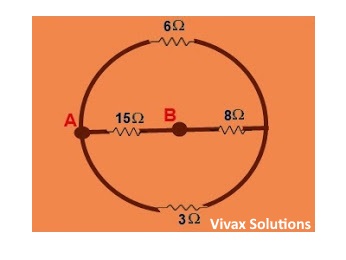
Ans:6 Ω
You can practise the calculations involving the resistors in series and parallel here. Just move the sliders and see how the total resistance changes.
Next
Previous